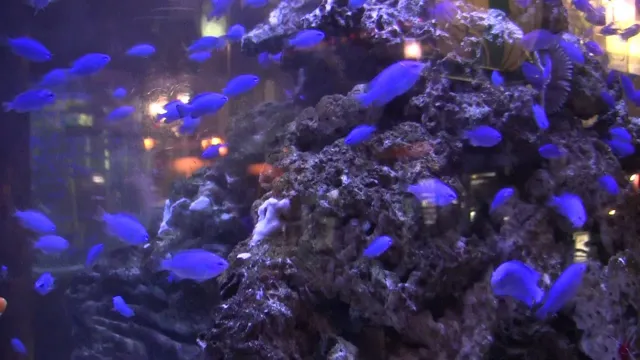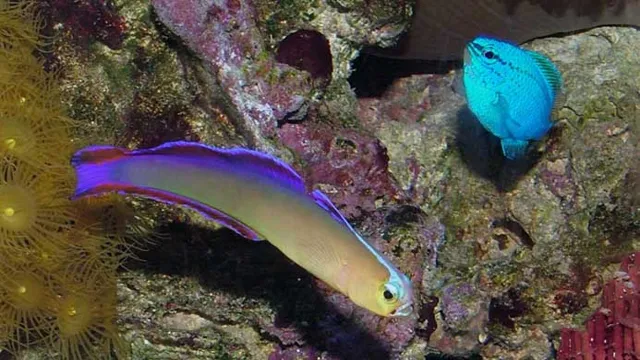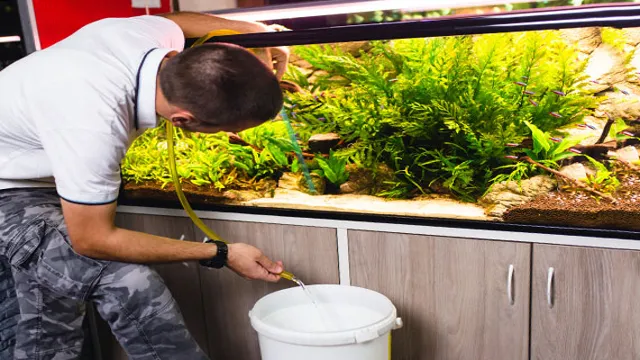Do you have a thriving aquarium in your home? Are you looking for new and exciting additions to your aquatic family? Look no further than damselfish. These beautiful and active swimmers are a great addition to any aquarium, but catching them can be a challenge. With their quick movements and ability to hide in your underwater landscape, damselfish can be tricky to capture.
However, with a few simple tips and tricks, you can easily catch these stunning fish and introduce them to your aquarium. First, start with a well-planned strategy. Damselfish are best caught using a net, but you’ll need to be strategic in your approach.
Watch their movements carefully and try to anticipate where they will swim next. This will give you the best chance of catching them quickly and efficiently. It’s also important to create a calm and stress-free environment for your damselfish.
Use a smaller net and avoid chasing them around the aquarium. Instead, let them calmly swim into the net on their own. Once you’ve successfully caught your damselfish, introduce them to their new home slowly.
Keep them in a separate container for a short period of time before introducing them to your aquarium. This will allow them time to adjust to the new environment without being overwhelmed. Catching damselfish may seem like a daunting task, but with a bit of patience and practice, it can be a fun and rewarding experience.
Just remember to plan your approach carefully, create a calm and stress-free environment, and introduce them to their new home slowly.
What are Damsels?
Damsels are small, colorful fish that are commonly found in saltwater aquariums. They are known for their animated personalities and make great additions to any fish tank. If you’re wondering how to catch damsels in your aquarium, it can be quite easy.
One method is to use a fishnet and slowly move it towards the fish, being careful not to scare them away. Another option is to use a baited trap, which can lure the fish in and safely catch it. When choosing a trap, be sure to select a size appropriate for the damsel and bait it with something they find irresistible, like small pieces of shrimp or bloodworms.
Once caught, damsels require a well-maintained aquarium with plenty of hiding spots and a balanced diet of fish food and live prey. So, if you’re ready to add some colorful and entertaining fish to your aquarium, consider investing in some damsels and follow these tips for catching and caring for them.
Description of Damsels
Damsels are small, colorful, and often dazzling fish that belong to the family Pomacentridae, which includes more than 300 species. These fishes are typically found in shallow, warm waters of the tropics and subtropics, commonly dwelling in coral reefs. They are commonly seen darting in and out of crevices and hiding in the nooks and crannies of the reefs.
Damsels are best known for their vibrant colors and patterns, ranging from solid blues, purples, and yellows to striped or spotted varieties. These fish are quite hardy and can be easy to care for, making them very popular with aquarium owners. While they are small in size, they are also known for having fierce personalities, sometimes becoming territorial and aggressive towards other fish in their habitat.
Overall, damsels are beautiful and fascinating creatures that add vibrancy and activity to any marine environment.

Materials Needed to Catch Damsels
If you’re looking to add some beautiful damselfish to your aquarium, it’s important to catch them in a humane and safe way. To do this, you’ll need a few essential materials. Firstly, you’ll need a small net that can easily fit into your tank.
You don’t want to use a net that is too large or you may have trouble maneuvering it in the confined space. Secondly, you’ll need a container to hold the damselfish as you catch them. This can be anything from a plastic bag to a specialized holding container.
It’s important that the container is made of non-toxic materials and has enough oxygen for the fish to breathe. Lastly, you’ll want to have some food on hand to entice the damselfish into the net. This can be anything from frozen or live brine shrimp to small bits of algae or pellet food.
Remember to be patient and gentle when catching your damselfish, as they are delicate creatures. With these essential materials, you’ll be able to safely and effectively catch your new aquatic pets.
Fishing Net
If you are planning to catch damselfish, you need to have the proper materials that will help you in your fishing venture. One of the essential tools is a fishing net. A good-quality fishing net can help you catch these tiny, fast-swimming fish quickly and efficiently. (See Also: How to Calculate Gallons in an Aquarium: A Step-by-Step Guide)
The size of the net will depend on the size of the damselfish you want to catch – a smaller mesh will work better if the fish you are looking to catch is small. You can also consider getting a circular or rectangular frame that you can attach the mesh to, which makes it easier to maneuver while fishing. Besides, make sure to select a durable and lightweight material for the frame and handle, as it will be easier to handle while fishing.
With the right materials, you can catch damselfish with ease and enjoy the experience of fishing.
Container
When it comes to catching damsels, a container is a must-have. This is because damsels are small and fast, so you need something to contain them as you catch them. The best container to use is a clear, plastic container with a lid that has small holes to allow air to circulate.
This container should be big enough to hold the damsels you catch but not too big that they can swim around and hurt themselves. Additionally, you will need a net to catch the damsels with and a small cup to transfer them from the net to the container. Remember to always handle the damsels with care and release them back into their natural habitat as soon as possible.
By using the right container and tools, you can safely and effectively catch damsels for scientific research or as a hobby.
Food or Bait
When it comes to catching damselfish, food or bait is essential. You’ll need to bring along some materials to attract these elusive and territorial fish. One option is to use shrimp or small pieces of fish as bait.
However, you can also use artificial lures that resemble small fish or even damselfish themselves. If you want to go the natural route, it’s best to bring along a small net or trap to catch live bait. Some popular options include ghost shrimp and small crabs.
These can be used to not only catch damselfish but other fish species as well. Regardless of your bait of choice, be sure to bring along some extra line and hooks just in case. With the right materials and some patience, you’ll be able to successfully catch these colorful and lively fish.
Preparation
Catching damsels in your aquarium can be challenging if you’re not prepared. First, you’ll need to make sure that you have the right equipment, such as a small net and a quarantine tank. It’s also important to familiarize yourself with the different types of damsels and their behaviors, as this will help you determine the best way to catch them.
For example, some damsels are more skittish than others and may require a slow and careful approach. You should also consider the time of day when attempting to catch your fish, as they are likely to be less active and easier to catch during their resting hours. Lastly, you should be gentle when handling your damsels, as they can easily get injured or stressed if mishandled.
With a little preparation and patience, you’ll be able to catch your damsels and introduce them to their new home in your aquarium.
Feed the Damsels and Observe Their Behaviors
Before you can start observing the behaviors of damselflies, you need to prepare their food. For this, you’ll need to purchase some aquatic invertebrates such as Daphnia, bloodworms, or small pieces of shrimp. These can be easily found at your local aquarium store or even ordered online.
Once you have your food ready, you’ll need to place it in a shallow dish or container and add some water. Make sure the container is placed in a safe area, away from any predators that may harm the damselflies. It’s important to note that only feed them small amounts at a time, as overfeeding can lead to water contamination or health problems for the damselflies.
Providing them with the right food and in the right amount will allow you to observe their natural behaviors and interactions in their habitat.
Lower the Water Level
Lowering the water level in your swimming pool is an important step in preparing for the winter season. The first step is to turn off the power supply to the pump and drain any excess water from the filter. Next, attach a garden hose to the filter drain and direct the water away from the pool.
This will lower the water level to just below the skimmer’s level. It’s important to note that if you live in an area where the temperatures drop below freezing, you should lower the water level an additional three to six inches to prevent any damage to the skimmer or pool walls. Once the water level has been lowered, remove any debris from the water, and cover the pool with a winter cover.
By following these simple steps, you can ensure that your pool is ready to face the winter season and will be in good condition when you’re ready to use it again in the spring. (See Also: How to Design an Aquarium Stand: Tips and Tricks for a Stunning Display)
Remove Obstacles
Preparation for removing obstacles is key to achieving success. It’s important to identify potential roadblocks before they become an issue and to create a plan for overcoming them. This includes gathering information, identifying resources, and building the skills necessary to tackle the challenge.
By doing this, you’ll be better equipped to address issues as they arise and minimize their impact. It’s also important to stay motivated and focused on your goals, even when faced with setbacks. Remember that obstacles are a normal part of any journey, and it’s through overcoming them that we grow and improve.
So don’t let a hurdle stop you from achieving what you set out to do. With the right mindset and preparation, anything is possible.
Catching the Damsels
Catching damselfish can be a daunting task, but with the right tools and techniques, it can be a breeze. One of the easiest methods is using a fish trap. A trap can be created from a plastic bottle by cutting off the top and inverting it into the bottom half, creating a funnel-like shape.
Place food at the bottom of the bottle and wait for the damselfish to swim inside. Another method is using a hand net to scoop the fish out of the water. This requires some skill and patience as damselfish can be fast swimmers and may require several attempts before successful.
It’s important to use a net with small holes to prevent the fish from slipping through. Additionally, damsels are attracted to light, so using a light trap can be another option. With a little bit of practice, catching damsels can be both rewarding and satisfying.
Use the Fishing Net
Fishing nets have been used for centuries to catch fish, but did you know they can also be used to catch damselflies? These delicate creatures are a stunning sight to behold, with their intricate wings and colorful bodies, and catching them with a fishing net can be a thrilling experience. To catch damselflies, you’ll need a fine mesh net with a long handle and a keen eye to spot them in the wild. Once you have your net and spot a damselfly, approach slowly and carefully to avoid scaring it off.
When you are close enough, gently scoop it up in the net, taking care not to damage its wings. Then, release it back into the wild after admiring its beauty up close. Using a fishing net is a great way to observe and appreciate these small wonders of nature without causing any harm.
So, next time you are out by the water’s edge, bring your fishing net and try your hand at catching some damselflies. Who knows what other treasures you might find?
Use the Bait Method
The “bait method” can be a great way to catch damsels, whether in a fishing pond or in relationships. Essentially, it involves presenting something attractive or enticing to the target to draw them in closer. In terms of fishing, this could be using a tasty snack or a brightly colored lure to catch the fish’s attention before reeling them in.
Likewise, in relationships, we might present ourselves in a particular way or showcase certain traits or interests that we know will appeal to the person we’re interested in. However, it’s important to note that baiting can become manipulative if taken too far, so it’s important to use it ethically and with consideration for the other party’s feelings. By offering something of value that is genuine and authentic, we can attract damsels without resorting to deceit or trickery.
Avoid overcatching
Overcatching of damsels can have a significant impact on their population in the long run. It’s essential to understand that damsels are not just fish; they play a crucial role in the ecosystem, serving as both predator and prey. When they are overcaught, it can lead to an imbalance in the ecosystem, which can have devastating effects.
As anglers, we need to be aware of our catch. One way to do this is to avoid using small hooks that are more likely to catch everything that comes along. Instead, try using larger hooks, which will not only help in preventing overcatching but will also target larger fish.
Remember, it’s not only about catching as much as possible but also about having a sustainable fishery for future generations.
Conclusion
In summary, catching damsels in an aquarium requires a delicate balance of patience, precision, and persistence. From careful observation of their behavior to strategic placement of traps, these fish are not easily caught. But with a little creativity and a lot of determination, you too can snag some damsels and add some aquatic splendor to your tank.
So go forth and fish, my friend, and may the odds be ever in your favor!” (See Also: How to Jumpstart a New Aquarium: Tips for Beginner Fish Keepers)
Safety Tips for Catching Damsels
When catching damsels, safety should be a top priority. These beautiful fish are a popular choice among aquarium enthusiasts and can be found in many local pet stores. However, it is important to know how to safely catch and transport them to their new home.
Begin by turning off the aquarium lights to decrease their stress levels. Then, use a small net and slowly and gently scoop the damsel into a clear, plastic bag filled with water from their current aquarium. Make sure to avoid overcrowding the bag and transport them as quickly as possible to their new home.
By following these simple steps, you can ensure the safety and wellbeing of your damsels during their transition to their new aquarium.
Damsels Make Great Pets
Damsels are a popular choice for marine hobbyists looking to keep a pet fish with vibrant colors and an active personality. However, catching the damsels is no easy feat. These fast-swimming fish can be elusive, and chasing them around the tank with a net can cause stress and harm.
A better approach is to lure them into a trap, such as a clear plastic bottle with holes drilled in it. Simply place food inside the bottle, and the curious damsels will swim in, but struggle to find their way back out. Once captured, it’s important to acclimate the damsels slowly to their new environment, to avoid shock or disease.
With proper care and attention, damsels can make great pets, adding beauty and personality to any marine aquarium setup.
FAQs
What are the ideal water parameters for damsels in an aquarium?
The ideal water temperature for damsels in an aquarium ranges from 72-78°F, with a pH of 8.1-8.4 and a salinity level of 1.020-1.025.
What are some compatible tank mates for damsels in an aquarium?
Compatible tank mates for damsels in an aquarium include clownfish, cardinals, gobies, and blennies.
How often should I feed my damsels in an aquarium?
Damsels should be fed small amounts multiple times a day, as they have a high metabolism. Feed them a variety of foods such as flakes, pellets, and frozen food.
How do I acclimate my damsels to the new aquarium environment?
Float the bag containing the damsels in the aquarium for 15-20 minutes to equalize the temperature, then gradually add small amounts of water to the bag over the course of 30-45 minutes until the water conditions in the bag match the aquarium.
Can damsels be kept in a reef aquarium?
Yes, damsels can be kept in a reef aquarium; however, some species are known to be aggressive towards coral and invertebrates.
How many damsels can be kept in a 30-gallon aquarium?
It is recommended to keep no more than 3-4 damsels in a 30-gallon aquarium.
Can damsels be kept with other aggressive fish species?
Damsels can be kept with other aggressive fish species; however, careful monitoring of their behavior is required to prevent aggression and ensure the safety of other tank mates.







